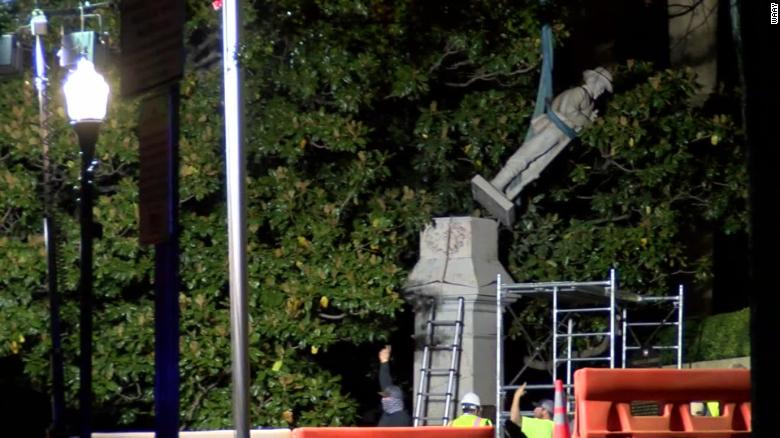A Confederate monument that stood at the steps of the Montgomery County, Alabama, courthouse for over a century now resides in a cemetery.
For months, the memorial, topped with a statue of a Confederate soldier, had faced protests and vandalism.
Over the summer, protesters, along with various groups including Black Lives Matter, the Rosa Parks Day Committee and local church pastors, had urged officials to remove it, according to CNN affiliate WAAY-TV. The relocation had also faced opposition.
Finally, beginning around 11 p.m. Friday, Huntsville city officials began relocating the monument of General John Morgan, a Kentucky plantation owner, according to CNN affiliate WAAY-TV.
Crews removed the monument in five chunks over the course of several hours as a large crowd looked on, WAAY-TV reported.
“It’s just a good time. People are relaxed, they’re cheering,” WAAY-TV quoted Joretha Wright, who watched the removal, as saying.
“It’s just a nice feeling with everything that has been going on and all the tension and division, it’s just nice that something like this that’s caused so much chaos is actually bringing people together,” she said.
The monument was then placed among Confederate soldiers buried at Maple Hill Cemetery, which is on the National Register of Historic Places.
A national movement
Since the death of George Floyd by police in May, more than 40 Confederate symbols, from century-old monuments to a state flag, have been taken down across the country, according to the Southern Poverty Law Center.
More than a dozen schools and roads named after Confederate leaders have also been renamed.
Madison County Commissioner JesHenry Malone said in a statement provided to CNN, however, that the debate to find a way to legally remove the statue began internally months before Floyd’s death.
“We know that government can be bureaucratic at times and often slower than what we would prefer, but we had no desire to violate our oaths of office to appease public sentiment,” Malone stated.
Plus, they were battling Alabama’s Memorial Preservation Act, enacted in 2017, which bars the removal, renaming and alteration of monuments, memorial streets, and memorial or architecturally significant buildings that have been located on public property for 40 or more years.
‘A day for continued growth and healing’
Malone said he had received three letters in opposition to the monument’s removal.
The Heritage Protection of North Alabama and the United Daughters of the Confederacy, the original donors of the statue, tried to stop the relocation just hours before it was completed, WAAY-TV reported.
One member of the United Daughters of the Confederacy stated in an affidavit that she fears the statue wouldn’t be as protected at the cemetery as at its courthouse location, with lights and more public police presence, according to WAAY-TV.
Malone knows not everyone is celebrating the move.
“Today is a monumental day… I will not mark this day as a day of celebration but rather a day of continued growth and healing,” Malone said in his statement.
As for what will go in the spot where the controversial memorial stood, Malone told CNN they will soon have a new administrative building, and they hope to expand the current courthouse.
>>>details



